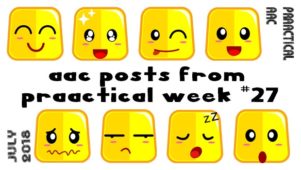How We Do It: Pragmatic Skill Intervention in AAC with Dr. Jill Senner & Matthew Baud
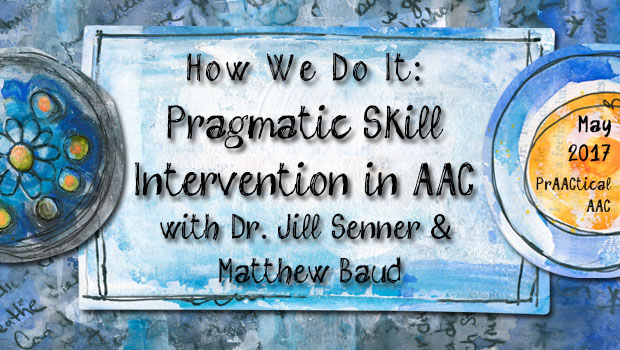
 Better Hearing and Speech Month is in full swing and we are excited to see SLPs talking about tools and strategies for supporting people with AAC needs.
Better Hearing and Speech Month is in full swing and we are excited to see SLPs talking about tools and strategies for supporting people with AAC needs.
Many individuals with AAC needs have difficulty using language in expected ways, particularly in social interactions. In this post, we welcome back guest authors Jill Senner and Matthew Baud to discuss ways in which they target pragmatic language in their clinical work. They have a prAACtical approach to this subject and are generous in sharing AAC resources, including vocabulary/pagesets for some popular AAC apps/SGDs.
Enjoy!
:::::::::::::::::::::::::::::::::::::::::::::::::::::::::::::::::::::
Chat with Me: Pragmatic Skill Intervention in AAC with Jill E Senner, PhD, CCC-SLP & Matthew R. Baud, MS, CCC-SLP
Pragmatic skills, commonly referred to as social skills, play an important role in the successful integration of individuals with disabilities. People with disabilities need adequate social skills to live and be educated in the least restrictive environment, to be competitively employed and for overall quality of life. A number of studies have suggested that some individuals using AAC may exhibit difficulties with social language.
Fortunately, there are strategies that are helpful in improving social skills in children, teens, and young adults using AAC. Below are some strategies we know and love:
- Set Appropriate Goals
The first step in intervention is to identify areas of need to help set appropriate goals. To do this, we frequently use the Pragmatics Profile. The Pragmatics Profile from the Clinical Evaluation of Language Fundamentals – 5th Edition (CELF-5) is a 50-item checklist that provides normed scores on verbal and nonverbal social communication skills (such as “uses strategies for responding to interruptions and interrupting others”). Each item on the questionnaire is rated on a 4-point Likert-type scale with the number checked related to the frequency of occurrence of each skill (ranging from never/almost never to always/almost always). Following testing, an item analysis can be done to identify an individual’s strengths and needs to help set appropriate goals. As per the examiner’s manual, those behaviors that are rated as “sometimes” or “never” may be appropriate targets for direct intervention.
- Examine Vocabulary
If an individual is not performing a given skill, examine vocabulary. In 2011, we evaluated parent perceptions of pragmatic skills in individuals using AAC. In this study, parent comments suggested that although language deficits may have been related to users’ social skills, social competence may have also been influenced by a lack of social skills instruction, inadequate vocabulary, and a lack of communication partner education. Indeed, “when an individual who uses AAC is not able to program his or her own system, communication partners must be mindful of the vocabulary needed for social participation…” (Senner, 2011, p. 107).
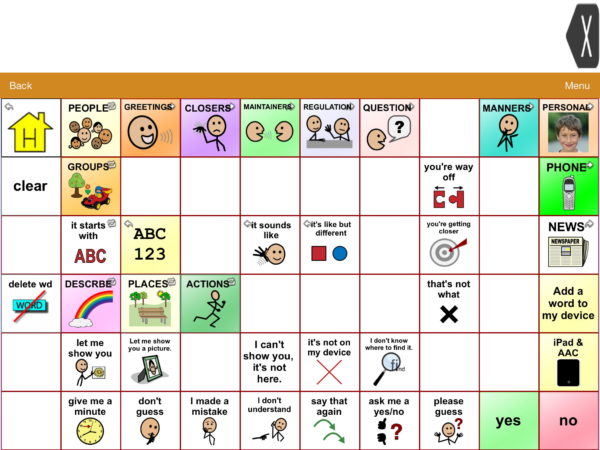
This screen shot of the repairs page on a 60-location TouchChat vocabulary demonstrates some messages individuals using AAC can use to clarify their message in the event of a communication breakdown.
To address the need for fast access to social language on some speech generating devices, we have developed free add-on social pages for use with core vocabularies. The pages have been designed to expand availability of vocabulary to allow people who use AAC to perform a variety of pragmatic functions such as making/responding to greetings to/from others, maintaining topics using typical responses, and asking for/responding to requests for clarification during conversation. These pages provide quick words and phrases for participation in time-dependent activities, such as making a phone call, while still providing access to a user’s existing core vocabulary. The following pages are included: starters/greetings, closers, conversational maintainers, regulation vocabulary, social questions, repair strategies, manners, telephone and news. The pages and handy video tutorials on installing them can be found here. New pages are currently being developed for use with additional vocabularies.
- Model Language
Partner-augmented input (PAI), also known as aided language input, is a powerful, evidence-based approach in which communication partners point to the symbols on the child’s communication board or device while simultaneously talking. This modeling can and should be provided in the natural environment to demonstrate when and how to use targeted pragmatic skills.
- Use Evidence-Based Direct Intervention Strategies
Some social skills can be targeted through indirect intervention, however others will require direct intervention. Many of the same strategies proven to be effective with other populations have also been shown to be effective with teens and young adults using AAC (Senner & Baud, 2015), particularly when used in combination. The strategies we typically use together are social stories, video models, and scripts.
Carol Gray defines social stories as individualized short stories written from a child’s perspective that explain challenging social situations through visual supports and text.
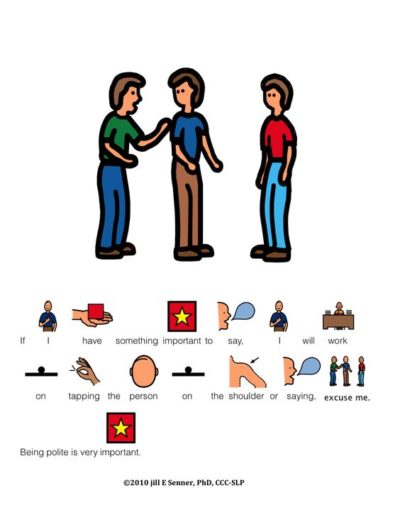
This page from our Interrupting social story illustrates a directive sentence, which identifies a suggested response to a situation, gently directing the behavior of the individual using AAC (i.e., to say “excuse me” to interrupt when necessary).
Video modeling involves a child watching videotapes of positive examples of adults, peers, or him- or herself engaging in a social skill (such as a interrupting) that is being taught.
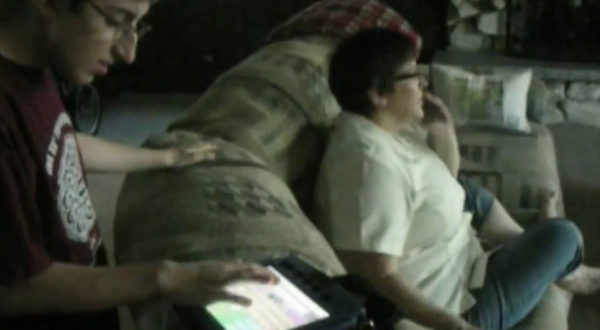
This video used in our intervention research illustrates an individual using the responses suggested in the interrupting social story (i.e., tapping a partner on the shoulder and saying, “excuse me.”) This video model also mirrors the script (see below) used during the study.
Scripts can be audio, written words, phrases, or sentences that enable an individual to perform a desired social skill. Note that scripts should have roles for all who will participate. Scripts can be used during role-playing scenarios and should be faded to promote generalization.
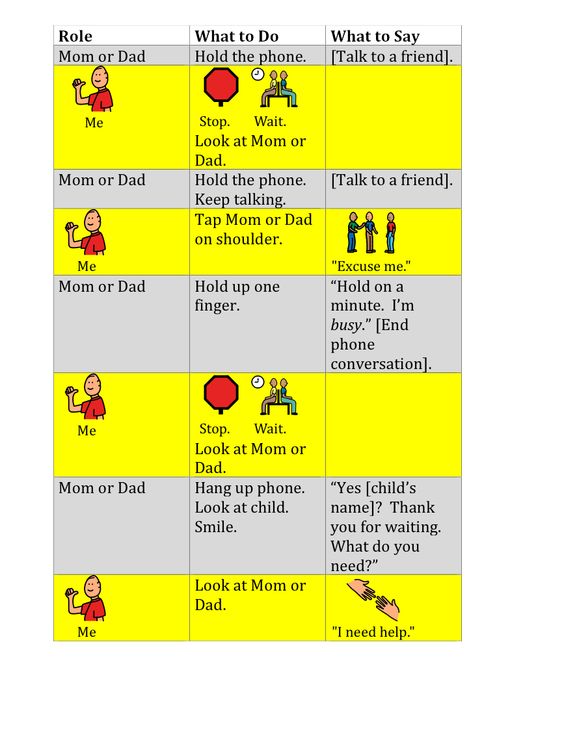
This script from our intervention study reinforces the use of the strategies suggested for interrupting.
- Promote Generalization
The use of a social skill will be facilitated by teaching the skill in a variety of settings and in response to a variety of persons. Using naturally occurring social reinforcers such as smiling or saying, “thank you” will improve generalization as well.
A PDF version as well as a single switch adapted PowerPoint version of the Interrupting social story used in our intervention research as well as the script pictured above can be downloaded for free from our Pragmatic Skills Pinterest Board. Additional social stories, scripts, and video models for other communicative functions are currently being developed. Check the Technology & Language Center, Inc. website for updates.
References
Senner, J. E. (2011). Parent Perceptions of Pragmatic Skills in Teens and Young Adults Using AAC. Communication Disorders Quarterly, 32, 103-108.
Senner, J. E. & Baud, M. R. (2015, October). Chat with Me: Pragmatic Skill Intervention in Augmentative and Alternative Communication. Closing the Gap, Minneapolis, MN.
Contact information
- Jill E. Senner: @JillESenner; http://www.talcaac.com/; https://www.facebook.com/TechnologyLanguageCenterInc/ ; https://www.pinterest.com/talcaac/
- Matthew R. Baud: @mbaud12 ; https://sites.google.com/a/ntdse.org/assistivetechnology/home
Filed under: Featured Posts, PrAACtical Thinking
Tagged With: EBP, intervention, pragmatics, Social Language
This post was written by Carole Zangari


